-
Paper Information
- Next Paper
- Previous Paper
- Paper Submission
-
Journal Information
- About This Journal
- Editorial Board
- Current Issue
- Archive
- Author Guidelines
- Contact Us
Energy and Power
p-ISSN: 2163-159X e-ISSN: 2163-1603
2012; 2(1): 9-17
doi: 10.5923/j.ep.20120201.02
Application of Thermal Barrier Coatings in Diesel Engines: a Review
Vinay Kumar Domakonda , Ravi Kumar Puli
Department of Mechanical Engineering, National Institute of Technology, Warangal, 506004, India
Correspondence to: Vinay Kumar Domakonda , Department of Mechanical Engineering, National Institute of Technology, Warangal, 506004, India.
| Email: |  |
Copyright © 2012 Scientific & Academic Publishing. All Rights Reserved.
A review of research on low heat rejection engines, to incorporate various systems of ceramic materials in intermittent combustion engines, and on the use of ceramics in these engines is presented. The reduction of heat loss from the combustion chamber of diesel engines improves fuel efficiency only by 3 or 4 per cent. Some other gains may be possible from a smaller cooling system, recovery of exhaust energy, and improvements in aerodynamics. The use of thermal barrier coatings (TBCs) to increase the combustion temperature in diesel engines has been pursued for over 20 years. Increased combustion temperature can increase the efficiency of the engine, decrease the CO and (possibly) the NOx emission rate. However, TBCs have not yet met with wide success in diesel engine applications because of various problems associated with the thermomechanical properties of the coating materials. Although, the in-cylinder temperatures that can be achieved by the application of ceramic coatings can be as high as 850-9000C compared to current temperatures of 650-7000C. The increase in the in-cylinder temperatures helped in better release of energy in the case of biodiesel fuels thereby reducing emissions at, almost the same performance as the diesel fuel. The purpose of this paper is to explain the effect of insulation on engine performance, heat transfer characteristics, combustion and emission characteristics. Many researchers have carried out a large number of studieson Low Heat Rejection Engine (LHRE) concept. Some of them are experimental work and many are theoretical studies. In the case of LHR engines almost all theoretical studies predict improved performance but many experimental studies show different picture. This paper analyses the reason for this deviation. The operating conditions, under which the experimental and simulation studies are carried out, have been clearly discussed. The factors, which affect thermal efficiency, combustion, and exhaust emissions in LHR engine, are deduced and their influences discussed.
Keywords: Thermal Barrier Coatings, Low Heat Rejection Engine, Biodiesel
Cite this paper: Vinay Kumar Domakonda , Ravi Kumar Puli , "Application of Thermal Barrier Coatings in Diesel Engines: a Review", Energy and Power, Vol. 2 No. 1, 2012, pp. 9-17. doi: 10.5923/j.ep.20120201.02.
Article Outline
1. Introduction
- Energy conservation and efficiency have always been the quest of engineers concerned with internal combustion engines. The diesel engine generally offers better fuel economy than its counterpart petrol engine. Even the diesel engine rejects about two thirds of the heat energy of the fuel, one-third to the coolant, and one third to the exhaust, leaving only about one-third as useful power output. Theoretically if the heat rejected could be reduced, then the thermal efficiency would be improved, at least up to the limit set by the second law of thermodynamics. Low Heat Rejection engines aim to do this by reducing the heat lost to the coolant.Thermal Barrier Coatings (TBCs) in diesel engines lead to advantages including higher power density, fuel efficiency, and multifuel capacity due to higher combustion chamber temperature (900℃ vs. 650℃)[2,3].Using TBC can increase engine power by 8%, decrease the specific fuelconsumption by 15-20% and increase the exhaust gastemperature 200K[5]. Although several systems have been used as TBC for different purposes, yttria stabilized zirconia with 7-8 wt. % yttria has received the most attention. Several important factors playing important roles in TBC lifetimes including thermal conductivity, thermal, chemical stability at the service temperature, high thermo mechanical stability to the maximum service temperature and at last but not least the thermal expansion coefficient (TEC). The diesel engine with its combustion chamber walls insulated by ceramics is referred to as Low Heat-Rejection (LHR) engine. The LHR engine has been conceived basically to improve fuel economy by eliminating the conventional cooling system and converting part of the increased exhaust energy into shaft work using the turbocharged system.A large number of studies on performance, structure and durability of the LHR engine have been carried out since Kamo and Bryzik[6] presented a new concept of the LHR engine combined with the turbocompound system. Although promising the results of the investigations have been somewhat mixed. Most have concluded that insulation reduces heat transfer, improves thermal efficiency, and increases energy availability in the exhaust. However contrary to the above expectations some experimental studies have indicated almost no improvement in thermal efficiency and claim that exhaust emissions deteriorated as compared to those of the conventional water-cooled engines.Plasma spray is the most common method of depositing TBCs for diesel applications. It creates a splat structure with 10-20 % volume fraction of voids and cracks[7]. High porosity of this structure makes it an ideal choice for TBC. Widespread application has been limited by insufficient lifetimes and the cost. TBCs for diesel engines have generally been accepted to improve engine thermal efficiency and reduce emissions as well as specific fuel consumption because of their ability to provide thermal insulation to the engine components. The generally known principle that increased operation temperatures in energy conversion systems lead to an increase in efficiency, fuel savings and reduced emissions as particles, carbon monoxides (CO), hydrocarbons (HC) and limited reductions of NOx emissions have, over many decades, promoted R&D activities in the field of TBCs development[8].
2. TBC in Diesel Engine vs. Turbine Blade
- Recently, much attention has been focused on TBCs for turbine engines. However, the service environment of the coating in the turbine is markedly different than in the diesel engine. In the former, the service temperature is high (1000-1100℃). The super alloy substrate’s maximum service temperature is about 800℃. The thickness of coating is a few hundred microns and is applied to protect against oxidation, hot corrosion, thermo-mechanical fatigue and creep. Due to the high substrate temperature, oxidation of the bond coat plays a major role in coating failure. On the other hand, in the diesel engine the gas temperature, currently less than 750℃, would ideally approach 900℃. The substrate temperature is limited to approximately 200℃, and therefore a thick coating (at least 1mm) is required which leads to a high thermal gradient. In a thick thermal barrier coating (TTBC) the bond coat temperature is too low for severe oxidation and creep[7]. Recent work shows that inelastic behavior of the TTBC ceramic material and its unique microstructure determines the failure mechanism. In a thick thermal barrier coating, when the surface of the YSZ coating is heated, a compressive stress is developed in the surface which will be relaxed after two hours of steady state heating. Upon cooling, the stress becomes tensile and initiates cracks. Due to the mismatch in thermo mechanical properties of the top coat and bond coat, this interface is a source for cracking and delamination[8].
3. Alternatives
- As mentioned above, conventional YSZ coatings have not proven successful for TBCs in diesel engines. There is a great thermal expansion coefficient match between YSZ, bondcoat and substrate (10.7x10-6 k-1 vs.17.5x10-6 k-1for NiCoCrAlY and 16x10-6 K-1 for IN737)[7]. Good thermo-mechanical performance and fair oxidation resistance are other properties of YSZ as a TBC. A number of materials have been proposed in the literature as possible alternative to YSZ for diesel engine applications. Each has advantages and disadvantages when compared with the standard coating.
3.1. Zirconates
- Zirconates have drawn the attention of several research groups as a promising alternative to YSZ. These materials with a pyrochlore structure [12] have a fair TEC (in the range of 9-10 x10-6 K-1) which is comparable with PSZ. The main advantages of zirconates are their low sintering activity, low thermal conductivity (20% lower than PSZ), and good thermal cycling resistance[13,14]. The main problem is the high TEC which results in residual stress in the coating, and can cause coating delamination. Some materials in this category; e.g. BaO·ZrO2, SrO·ZrO2, and La2O3·2ZrO2, undergo phase transformation or become non-stoichiometric during heating. The total porosity in plasma sprayed zirconates is less than 10%[12] which is lower than the porosity in plasma sprayed PSZ. As the porosity has a vital role in thermal insulation, process modification is required to increase the level.
3.2. Other Potential Alternative Ceramic Materials to PSZ
- Garnets Al2O3.SiO2.MgO system Cordierite Forsterite SpinelMullite
4. Multilayer System
- In a thick TBC, a low TEC is desirable for the hot surface to minimize thermally derived stresses and sensitivity to thermal shock. A large TEC mismatch with the metallic substrate limits coating adhesion. A multi-layer system may permit these opposing requirements to be satisfied. A set of chemically compatible materials have been identified which offer a range of TECs and acceptable thermal conductivities. Coupled analysis of the temperature and stress distribution through the thickness of the multi-layer coating is underway to evaluate stress levels in the coating during and after deposition and under service conditions. The goal is to optimize the thickness of each layer to minimize the stress in the coating under service conditions.
5. Experimental Studies on LHR Diesel Engine
- The motivating force behind the low heat rejection (LHR) engine has been the prospect to decrease of cooling load. Cooling system is there to keep engine-operating temperatures down to levels tolerated by currently used constructional materials and lubricants. If the energy normally rejected to the coolant could be recovered instead on the crankshaft as useful work, then a substantial improvement in fuel economy would be obtained. Increased thermal efficiency and elimination of the cooling system are the major promises of the LHR engine[15]. On the other hand, the LHR engine designs promise to meet the increasingly stringent regulations in the areas of fuel economy and permissible emissions levels[15,6]. At the same time, exhaust energy rise, which accompanies this, can be effectively used in turbocharged engines. Higher temperatures in the combustion chamber can also have a positive effect on diesel engines, due to the self-ignition delay drop[16,17].Can Hasimoglu at al[18] conducted various experiments on a turbocharged direct injection diesel engine coated with CaZrO3 using diesel and biodiesel fuels and reported that with the LHR diesel and STD diesel conditions the brake thermal efficiency was increased approximately 3%, 4% and 6.5%, respectively as shown Fig.1, compared to STD diesel condition. This can be explained as follows: although there is a difference between fuel’s lower heating values of approximately 14%, the engine power and torque decrease to a maximum of 4.5%. It is estimated that these circumstances increased the brake thermal efficiency in STD biodiesel condition. In LHR biodiesel and LHR diesel conditions due to the reduction of specific fuel consumption, the brake thermal efficiency was increased.
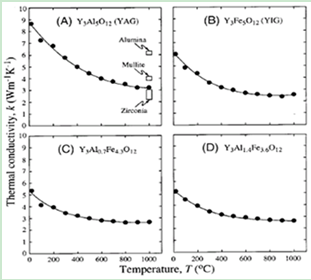 | Figure 1. Experimentally measured thermal conductivity of different garnets |
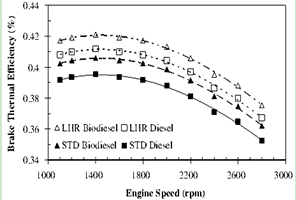 | Figure 2. The changes of brake thermal efficiency according to engine speed |
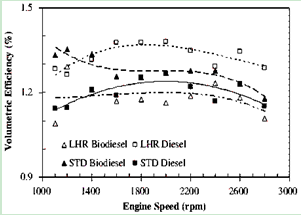 | Figure 3. The changes of volumetric efficiency according to engine speed |
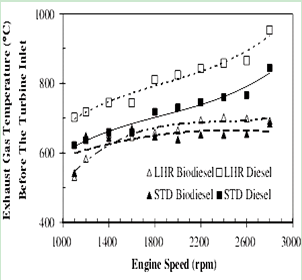 | Figure 4. The changes of exhaust gas temperatures according to engine speed |
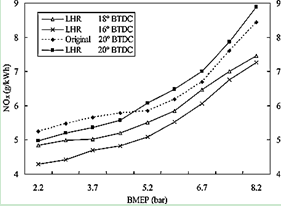 | Figure 5. Variation of Nox at different injection timings |
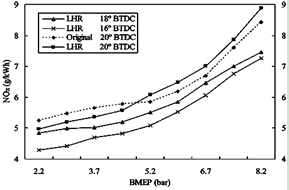 | Figure 6. Variation of NOx emissions with brake mean effective pressure for original engine with 20◦ BTDC and LHR engine with 20˚BTDC, 18˚BTDC, 16˚BTDC at 2400 rpm. |
6. Effect of Insulation on Engine Performance
6.1. Volumetric Efficiency
- Volumetric efficiency is an indication of breathing ability of the engine. It depends on the ambient conditions and operating conditions of the engine. Reducing heat rejection with the addition of ceramic insulation causes an increase in the temperature of the combustion chamber walls of an LHR engine. The volumetric efficiency should drop, as the hotter walls and residual gas decrease the density of the inducted air. As expected all the investigations [D.Assanis et al[28], J.A.Gatowski[25], R.H.Thring[26], Miyairi et al[20], Suzuki et al[27] and others] on LHR engine show decreased volum- etric efficiency. The deterioration in volumetric efficiency of the LHR engine can be preventedby turbocharging, and that there can be more effective utilization of the exhaust gas energy.
6.2. Thermal Efficiency
- Thermal efficiency is the true indication of the efficiency with which the chemical energy input in the form of fuel is converted into useful work. Improvement in engine thermal efficiency by reduction of in-cylinder heat transfer is the key objective of LHR engine research. Much work has been done at many research institutes to examine the potential of LHR engines for reducing heat rejection and achieving high thermal efficiency. Researchers such as C.H.Moore et al[28], A.C.Alkidas[24], R.H.Thring[26], T.Morel et al[29], and many others have reported improvement in thermal efficiency with LHR engine. They attribute this to in-cylinder heat transfer reduction and lower heat flux. How- ever investigations of others such as W.K.Cheng et al[30], G.Woschni et al[31], S.Furuhama et al[32], D.W.Dickey[35] and some others report that thermal efficiency reduces with insulation. They all attribute this to an increase in the conve- ctive heat transfer coefficient, higher heat flux (increase in in-cylinder heat transfer) and deteriorated combustion. The in-cylinder heat transfer characteristics of LHR engine are still not clearly understood. Thus the effect of combustion chamber insulation on reducing heat rejection and hence on thermal efficiency is not clearly understood as on date.
6.3. Fuel Consumption
- Numerous investigators have modeled and analyzed the effects of in-cylinder thermal insulation on fuel consumption. Researchers such as R.Kamo et al[33], V.Sudhakar[34], T.Yoshimitsu et al[45], W.R.Wade et al[40], K.L.Hoag et al[37] and T.Morel et al[29] have reported improvement in the reduction of fuel consumption in LHR engine. The level of improvement that has been predicted ranged from 2 to 12 %. They attribute this to insulation of in-cylinder components. It has been predicted that insulation of in-cylinder components is a more effective means of reducing heat rejection and reducing fuel consumption. The investigation of R.H.Thring[26] indicates reduction in fuel consumption, and attributes this to reduced friction due to increased wall temperature. He also states that there is no measurable improvement in fuel consumption based on the thermodynamics involved.
7. Effect of Insulation on Emission
7.1. Unburned Hydrocarbon
- The emission of unburned Hydrocarbon from the LHR engines is more likely to be reduced because of the decreased quenching distance and the increased lean flammability limit. The higher temperatures both in the gases and at the combustion chamber walls of the LHR engine assist in permitting the oxidation reactions to proceed close to completion. Most of the investigations show reduction in HC level. However investigations of Wade et al[19] and S.Hen- ningsen[36] indicate increased level of HC emissions. They attribute this to deterioration in diffusion combustion. The burning of lubricating oil due to high wall temperature is believed to be the other reason for increased UBHC level.
7.2. Carbon Monoxide
- NOx is formed by chain reactions involving Nitrogen and Oxygen in the air. These reactions are highly temperature dependent. Since diesel engines always operate with excess air, NOx emissions are mainly a function of gas temperature and residence time. Most of the earlier investigations show that NOx emission from LHR engines is generally higher than that in water-cooled engines. They say this is due to higher combustion temperature and longer combustion duration. The Investigation of Alkidas[24] reports an increase in the LHR engine NOx emissions and concluded that diffusion burning is the controlling factor for the production of NOx. Almost equal number of investigations report declining trend in the level of emission of NOx. For example the investigations of Wade et al[19] indicate reduction in NOx level. They reason this to the shortening of the ignition delay that decreases the proportion of the premixed combustion.
7.3. Smoke and Articulates
- It might be expected that LHR engines would produce less smoke and particulates than standard engines for reasons such as high temperature gas and high temperature combustion chamber wall. Earlier investigations show that smoke and particulates emission level increased in some cases and decreased in a few others. The results obtained by Wade et al[19] show significant reduction in smoke emission. They attribute this to enhanced soot oxidation, which was made possible by both the high combustion temperature and the intense turbulence created by the reversed squish. However investigations carried out at SWRI show increased level of smoke. They attribute it to increased oil consumption resulting from the loss of oil control at the higher temperatures. Factors such as short ignition delay, poor air-fuel mixing are also responsible for the formation of smoke and particulates.
8. Simulation Studies
- In the case of the insulated engine, cycle simulations are often used as predictive tools allowing an indication of the performance potential of a given design prior to conducting costly experiments. Numerous simulation studies have been carried out to analyze the performance of the insulated engine. These simulation works predict definite improve- ment in the thermal performance of Low Heat Rejection engines over the conventionally cooled engines. In most of the cases simulations are performed on turbocharged, heavy duty, high speed and multicylind- erdiesel engines. In some cases simulations arecarriedonsingle cylinder, light duty and direct injection diesel engines. Some of the simulations have included turbocomp- ound systems and Rankine bottoming cycle (Heat recovery systems). All the simulations are run at different load conditions and different level insulations starting from no insulation (corresponding to a base line engine) to perfect insulation (corresponding to a perfect LHR engine). Not only that in all these investigations, a constant air-fuel ratio is maintained for both LHR engine and as well as non-insulated (base line or conventionally cooled) engines to ensure compatible combustion. Also in most of the cases the peak pressure is maintained constant between insulated and non-insulated engine.The results consistently show an improvement in the thermal efficiency of insulated engines compared to that of baseline engine at all loads and speeds. The percentage of improvements increase with the degree of insulation. Heat recovery systems such as Turbo compound system and Rankine bottoming cycle additions have further improved the efficiency as expected. The specific fuel consumption varies from 2 to 17 %. This variation is mainly due to different amount of reductions in-cylinder heat rejections effected by degrees of insulations and different quantities of energy recovered from the exhaust.Y.Miyairi’s[20] Low Heat Rejection diesel cycle simulation consists of a gas flow model, a heat transfer model and a two-zone combustion model. The heat transfer model is used to determine convective and radiative heat transfer between the gas and the cylinder valve. Using combustion model the temperature and the chemical equilibrium compositions are determined. The gas flow model is used to determine the gas flow rates between the intake system, the cylinder and the exhaust system. The simulation has run at different loads, speeds and with different insulation materials such as Iron, PSZ and ZrO2. The investigation indicates improved thermal efficiency ranging from 2 to 2.7% compared to the base line engine. The gain in thermal efficiency due to insulation varies with different insulation materials. The investigation also indicates materials which are low thermal conductivity and lower heat capacity are advantageous in the tradeoff between thermal efficiency and NO emission. It also indicates increasing adiabaticity increases the emission of NO.The simulation of K.L.Hoag et al[37] has clearly shown improvements in fuel consumption, volumetric efficiency and exhaust temperature. The simulation is carried on 450 KW Cummins V903 engine with various levels of insulation. . The Partially Stabilized Zirconia (PSZ) is used as insulation material. The improvement in fuel consumption, volumetric efficiency and exhaust temperature with respect to degree of insulation are shown in figures 1, 2, 3. Similar trends exhibited in an earlier work by Annand[40] and in recent ones by Morel et al[29]. Some of the important experimental results are listed in Table 1.T. Morel et al[29] have developed a comprehensive analytical methodology describing the heat transfer process in reciprocating engines. It models convection and radiation heat transfer, friction-generated heat, transient and steady state heat conduction through engine structure and couples all of these with a thermodynamic cycle model. The methodology has been applied to a matrix of insulated diesel engine designs to make an assessment of the effects of various insulating strategies, utilizing the state of the art ceramics as well as hypothetical material of very low conductivity. Their investigation indicates substantial reduc- tion in combustion chamber heat transfer and considerable improvement in brake specific fuel consumption.J.F.Tovell[38] has developed a computer simulation for a highly rated turbocharged diesel truck engine. In this investigation comparisons are made between standard engine and engines with exhaust port, cylinder head, piston and cylinder liner insulated individually or in combination. The investigation indicates reduction of fuel consumption by about 7.5% at the expense of high exhaust temperatures and cylinder pressure. He attributes this to reduction in heat loss to the coolant by insulating the piston crown and cylinder.
9. Conclusions
- In this paper, the advantages and disadvantages of several materials for use as thermal barrier coatings in diesel engines were reviewed. A multi-layer system is a promising approach to satisfy the competing requirements of the coating. The thicknesses of the different layers must be optimized to minimize the stresses under service conditions.
References
| [1] | R. Soltani, H. Samadi, E. Garcia and T.W.Coyle, Development of Alternative Thermal Barrier Coatings for Diesel Engines, SAE Paper No. 2005-01-0650 |
| [2] | P. Ramaswamy, S. Seetharamu, K. B. R. Varma, N. Raman and K. J. Rao, “thermomechanical fatigue characterization of zirconia (8% Y2O3-ZrO2) and mullite thermal barrier coatings on diesel engine components: effect of coatings on engine performance”, Proc. Instn. MechEngrs., vol. 214, part.C (2000) 729-742 |
| [3] | D. Zhu, R. A. Miller, “thermal barrier coatings for advanced gas turbine and diesel engines”, NASA/TM—1999-209453 |
| [4] | T.Hejwowski, A.Weronski, “the effect of thermal barrier coatings on diesel engine performance”, Vacuum, 65 (2002) 427-432 |
| [5] | S.Ahmaniemi, C.Gualco, A.Bonadei, R.Di Maggio, “characterization of modified thick thermal barrier coatings”, Thermal Spray 2003, Ohio, USA, 1477-1486 |
| [6] | W. Bryzik, R. Kamo, TACOM/Cummins adiabatic engine program, SAE paper 830314, vol. 92, 1983, pp. 1.1063–1.1087 |
| [7] | X.Q.Cao, R. Vassenb, D. Stoeverb, “Ceramic materials for thermal barrier coatings”, J. Europ. Ceram. Soc., 24 (2004), 1-10 |
| [8] | G.Qian, T.Nakamura, C.C.Berndt, “Effects of thermal gradient and residual stresses on thermal barrier coating fracture”, Mechanics of Mater., 27, (1998) 91-110 |
| [9] | K.Kokini, Y.R.Takeuchi, B.D.Choules," Surface thermal cracking of thermal barrier coatings owing to stress relaxation: zirconia vs. mullite", Surf. & Coat. Tech., 82(1996) 77-82 |
| [10] | M.B.Beardsley, P.G.Happoldt and K.C.Kelley, E.F.Rejda and D.F.Socie, "Thermal barrier coatings for low emission, high efficiency diesel engine applications", SAE paper, No 1999-01-2255 |
| [11] | S.Rangaraji, K.Kokini, "Interface thermal fracture in functionally graded zirconiamullite-bond coat alloy thermal barrier coating", Acta Mater., 51(2003) 251-267 |
| [12] | J.Wu, X.Wei, N.P.Padture, P.G.Klemens, M.Gell, E.Garcı, P.Miranzo, M.I.Osendi, "low-thermal-conductivity rare-earth Zirconates for potential thermal barrier coating applications", J. Am. Ceram. Soc., 85, [12] (2002) 3031-35 |
| [13] | R.Vassen, X.Cao, F.Tietz, D.Basu, D.Stover, "Zirconates as new materials for thermal barrier coatings", J. Am. Ceram. Soc., 83, [8] (2000) 2023-28 |
| [14] | H.Lehmann, D.Pitzer, G.Pracht, R.Vassen, D.Stover,"thermal conductivity and thermal expansion coefficient of the lanthanum rare-earth-element zirconate system", J. Am. Ceram. Soc., 86, 8 (2003) 1338-44 |
| [15] | C.A. Amann, Promises and challenges of the low-heat-rejection diesel, Journal of Engineering for Gas Turbines and Power 110 (1988) 475–481 |
| [16] | R. Kamo, N.S. Mavinahally, L. Kamo, W. Bryzik, R. Schwartz, Injection Characteristics that Improve Performance of Ceramics Coated Diesel en-gines, Society of Automotive Engineers, 1999 |
| [17] | R.B. Coers, L.D. Fox, D.J Jones, Cummins uncooled 250 engines, in: SAE International Congress & Exposition, Michigan, February–March 1984 |
| [18] | Hasimoglu C, et al. Performance characteristics of a low heat rejection diesel engine operating with biodiesel. Renew Energy (2007), doi:10.1016/j.renene.2007.08.002 |
| [19] | W.R.Wade, P.H.Havstad, E.J.Ounsted, F.H.Trinkler and I.J.Garwin,”Fuel Economy Opportunities with an Uncooled DI Diesel Engine”, C432, pp.11-24, ImechE/SAE 1984 |
| [20] | Y.Miyairi, T.Matsuhisa, T.Ozawa, H.Oikawa and N.Nakashima,” Selective Heat Insulation of Combustion Chamber Walls for a DI Diesel Engine with Monolithic Ceramics”, SAE Paper No.890141 |
| [21] | C.J. Leising, G.P. Purohit, S.P. Degrey, J.G. Finegold, Waste heat recovery in truck engines, SAE paper 780686, 1978 |
| [22] | P.L. Herzog, L. Burgler, NOx reduction strategies for DI diesel engines, SAE paper 920470, 1992 |
| [23] | G. Maramatsu, A. Abe, K. Yosdiha, Catalytic reduction of NOx in diesel exhaust, SAE paper 930135, 1993 |
| [24] | A.C. Alkidas, The influence of partial suppression of heat rejection on the performance and emissions of a divided-chamber diesel engine, SAE paper 860309, 1986 |
| [25] | J.A.Gatowski, “Evaluation of a Selectively-Cooled Single Cylindered 0.5-L Diesel Engine”, SAE Paper No.900693 |
| [26] | R.H.Thring, “Low Heat Rejection Engines”, SAE Paper No.860314 |
| [27] | T.Suzuki, M.Tsujita, Y.Mori and T.Suzuki, “An Observation of Combustion of Phenomenon on Heat Insulated Turbocharged and Inter-cooled DI Diesel Engines”, SAE Paper No.861187 |
| [28] | C.H.Moore and J.L.Hoehne, “Combustion Chamber Insulation Effect on the Performance of a Low Heat Rejection Cummins V-903 Engine”, SAE Paper No.860317 |
| [29] | T.Morel, S.Wahiduzzaman, and E.F.Fort,”Heat Transfer Experiments in an Insulated Diesel”, SAE Paper No.880186 |
| [30] | W.K.Cheng, V.W.Wong and F.Gao, “Heat Transfer Measurement Comparisons in Insulated and Non-Insulated Diesel Engines, “SAE Paper No.890570 |
| [31] | G.Woschni, W.Spindler, and K.Kolesa, ”Heat Insulation of Combustion Chamber Walls – A Measure to decrease the Fuel Consumption of I.C.Engines?”, SAE Paper No.870339 |
| [32] | S.Furuhama and Y.Enomoto, “Heat Transfer into Ceramic Combustion Wall of Internal Combustion Engines” SAE Paper No.870153 |
| [33] | R.Kamo. andW.Bryzik. “Adiabatic Turbocompound Engine Performance Prediction”, SAE Paper No.780068 |
| [34] | V.Sudhakar, “Performance Analysis of Adiabatic Engine” SAE Paper No.820431 |
| [35] | D.W.Dickey, “The Effect of Insulated Combustion Chamber Surfaces On Direct-Injected Diesel Engine Performance, Emissions and Combustion”, SAE Paper No.890292 |
| [36] | S.Henningsen,”Evaluation of Emissions and Heat Release Characteristics from a Simulated Low Heat Rejection Engines”, SAE Paper No.871616 |
| [37] | K.L.Hoag, M.C.Brands and W.Bryzik, “Cummins/ TACOM Adiabatic Engine Program”, SAE Paper No 850356 |
| [38] | J.F.Tovell, “The Reduction Of Heat Losses To The Diesel Engine Cooling System”, SAE Paper No.830316 |
| [39] | N.P.Padture, P.G.Klemens, "low thermal conductivity in garnet", J. Am. Ceram. Soc., 80, 4 (1997) 1018-20 |
| [40] | Annand.W.D, “Heat Transfer In The Cylinder Of Reciprocating Internal Combustion Engines”, Proc. I MechE, Vol.177, No.36, 1963 |
| [41] | X.Q.Cao, R.Vassen, W.Jungen, S.Schwartz, F.Tietz, D.Stover, "thermal stability of Lanthanum Zirconate plasma-sprayed coating", J. Am. Ceram. Soc., 84, 9, (2001) 2086-90 |
| [42] | H.G.Wang, H.Herman, "thermomechanical properties of plasma-sprayed oxides in the MgO-Al2O3-SiO2 system", Surf. Coat. Tech., 42 (1990) 203-216 |
| [43] | H.G.Wang, G.S.Fischman, H.Herman, "plasma-sprayed cordierite: structure and transformations", J. Mater. Sci., 24 (1989) 811-15 |
| [44] | F.G.Razavy, D.C.VanAken, J.D.Smith, "effect of laser surface melting upon the devitrification of plasma sprayed cordierite", Mat. Sci. & Eng., A362 (2003) 213-222 |
| [45] | K.N.Lee, D.S.Fox, J.I.Eldridge, D.Zhu, R.C.Robinson, N.P.Bansal, R.A. Miller, "upper temperature limit of environmental barrier coatings based on mullite and BSAS”, NASA/ TM-2002-211372 |
| [46] | P. M. Pierz, "thermal barrier coating development for diesel engine aluminum pistons", Surf. & Coat. Tech., 61(1993) 60-66 |
| [47] | P.Ramaswamy, S.Seetharamu, K.B.R.Varma, K.J.Rao, "thermal shock characteristics of plasma sprayed mullite coatings", J. Thermal Spray Tech., 7, 4 (1998) 497-504 |
| [48] | D. Stover, C. Funke, "directions of the development of thermal barrier coatings in energy applications", J. Mater. Process. Tech., 92-93 (1999) 195-202 |
| [49] | E.M.Levin, C.R.Robbins, H.F.McMurdie, “Phase Diagrams for Ceramics”, the American Ceramic Society, Columbus, OH, Figure 712, P.246 (1964). |
 Abstract
Abstract Reference
Reference Full-Text PDF
Full-Text PDF Full-Text HTML
Full-Text HTML